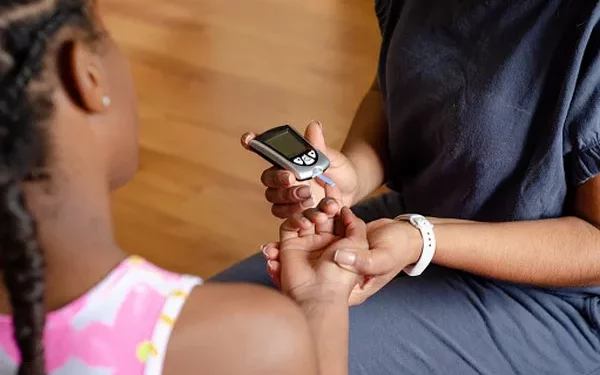Diabetes management hinges on the regular monitoring of blood glucose levels. One of the most common methods for checking these levels is the finger stick glucose test, a critical tool for individuals living with diabetes. This article will delve into the intricacies of this test, explaining its significance, methodology, and how it fits into broader diabetes care.
What is the Finger Stick Glucose Test?
A Brief Overview
The finger stick glucose test, also known as a capillary blood glucose test, is a quick and relatively painless method for measuring blood sugar levels. It involves pricking the finger with a small, sharp needle called a lancet to obtain a drop of blood. This blood sample is then placed on a test strip, which is inserted into a glucose meter to measure the blood glucose level.
Importance of Blood Glucose Monitoring
Why Monitoring is Crucial
For individuals with diabetes, maintaining blood glucose levels within a target range is vital to prevent both short-term and long-term complications. Regular monitoring helps in making informed decisions about diet, exercise, and medication, ultimately leading to better diabetes management and quality of life.
Preventing Complications
Consistent blood glucose monitoring can help prevent severe complications such as diabetic ketoacidosis (DKA), hyperosmolar hyperglycemic state (HHS), and long-term issues like neuropathy, retinopathy, and cardiovascular diseases. By understanding trends and patterns in blood glucose levels, individuals can take proactive steps to avoid these complications.
How the Finger Stick Glucose Test Works
Step-by-Step Procedure
Preparation: Gather the necessary supplies: a lancet, a glucose meter, test strips, and alcohol swabs.
Cleaning: Use an alcohol swab to clean the fingertip to prevent infection.
Pricking: Use the lancet to prick the side of the fingertip. The side is preferred over the center because it is less painful.
Sampling: Squeeze the finger gently to get a drop of blood.
Testing: Place the drop of blood on the test strip, which is then inserted into the glucose meter.
Reading: The glucose meter will display the blood glucose level within seconds.
Understanding the Results
Blood glucose levels are typically measured in milligrams per deciliter (mg/dL) in the United States and millimoles per liter (mmol/L) in many other countries. Normal fasting blood glucose levels range from 70 to 99 mg/dL (3.9 to 5.5 mmol/L), while postprandial (after eating) levels should be less than 140 mg/dL (7.8 mmol/L) in non-diabetic individuals.
Advantages of the Finger Stick Glucose Test
Convenience and Accessibility
The finger stick glucose test is portable and easy to use, making it convenient for frequent monitoring. It can be performed anywhere, from the comfort of one’s home to a professional healthcare setting.
Quick Results
One of the primary benefits of this test is the speed at which results are available. Within seconds, individuals can know their blood glucose levels, allowing for immediate action if necessary.
Challenges and Limitations
Pain and Discomfort
While the finger stick glucose test is generally well-tolerated, it can cause discomfort and pain, especially with frequent testing. Rotating the fingers used and using a high-quality lancet can help minimize these issues.
Accuracy Concerns
Factors such as improper technique, outdated or damaged test strips, and extreme temperatures can affect the accuracy of the results. It’s essential to follow the manufacturer’s instructions carefully and to calibrate the glucose meter regularly.
Integrating the Finger Stick Test into Diabetes Management
Daily Monitoring
For many individuals with diabetes, especially those on insulin therapy, daily blood glucose monitoring is crucial. The frequency of testing depends on various factors, including the type of diabetes, the treatment plan, and individual health goals.
Adjusting Treatment Plans
Regular monitoring allows for timely adjustments to treatment plans. For instance, if blood glucose levels are consistently high or low, healthcare providers can modify insulin dosages, oral medications, or recommend changes in diet and physical activity.
Technological Advancements in Blood Glucose Monitoring
Continuous Glucose Monitoring (CGM)
While the finger stick glucose test remains a staple in diabetes care, continuous glucose monitoring (CGM) systems offer a more comprehensive picture of glucose trends. CGM devices measure glucose levels in interstitial fluid and provide real-time data, reducing the need for frequent finger sticks.
Smartphone Integration
Modern glucose meters often come with Bluetooth capabilities, allowing data to be synced with smartphone apps. These apps can track trends, set reminders, and even share data with healthcare providers.
Best Practices for Accurate Finger Stick Testing
Proper Hand Hygiene
Always wash hands thoroughly with soap and water before testing. Alcohol swabs can also be used, but ensure the alcohol has dried completely to avoid dilution of the blood sample.
Choosing the Right Lancet
Use a lancet with an appropriate gauge to minimize pain and ensure an adequate blood sample. Lancets should be single-use to prevent infection and maintain sharpness.
Maintaining Equipment
Keep the glucose meter and test strips in a clean, dry place. Regularly check the expiration dates on test strips and ensure the meter is calibrated according to the manufacturer’s instructions.
When to Consult a Healthcare Provider
Unusual Patterns
If you notice unusual patterns or consistently high or low readings, it’s essential to consult a healthcare provider. They can help determine the cause and adjust your treatment plan accordingly.
Equipment Issues
If you suspect your glucose meter is malfunctioning, bring it to your healthcare provider. They can test its accuracy and recommend a replacement if necessary.
See also: When Should I Check My Sugar Levels?
Conclusion
The finger stick glucose test, or capillary blood glucose test, is a cornerstone of diabetes management. Despite the emergence of advanced technologies like continuous glucose monitoring, the finger stick test remains a reliable, accessible, and quick method for checking blood glucose levels. By understanding its importance, proper technique, and how to integrate it into a comprehensive diabetes care plan, individuals with diabetes can better manage their condition and prevent complications. Regular consultation with healthcare providers and staying updated on technological advancements will further enhance diabetes care and improve quality of life.
Related topics:
My Sugar Level is 300: What Should I Do?


























